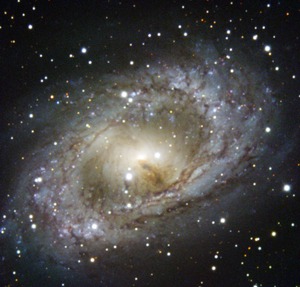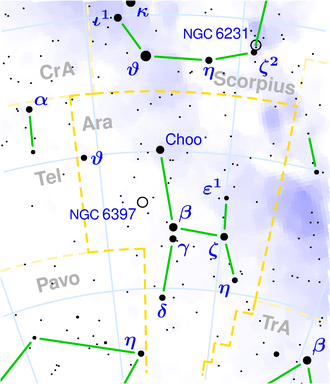NGC 6300
| Galaxy NGC 6300 |
|
|---|---|

|
|
| Image of the spiral galaxy with the help of the New Technology Telescope | |
| AladinLite | |
| Constellation | altar |
|
Position equinox : J2000.0 , epoch : J2000.0 |
|
| Right ascension | 17 h 16 m 59.5 s |
| declination | -62 ° 49 ′ 14 ″ |
| Appearance | |
| Morphological type | SB (rs) b / Sy2 |
| Brightness (visual) | 10.1 mag |
| Brightness (B-band) | 10.9 likes |
| Angular expansion | 4.3 ′ × 2.8 ′ |
| Position angle | 118 ° |
| Surface brightness | 12.7 mag / arcmin² |
| Physical data | |
| Redshift | 0.003706 ± 0.000050 |
| Radial velocity | (1108 ± 14) km / s |
|
Stroke distance v rad / H 0 |
(45 ± 3) x 10 6 ly (13.7 ± 1.0) Mpc |
| history | |
| discovery | James Dunlop |
| Discovery date | June 30, 1826 |
| Catalog names | |
| NGC 6300 • PGC 60001 • ESO 101-G025 • IRAS 17123-6245 • 2MASX J17165947-6249139 • VV 734 • GC 4273 • h 3668 • LDCE 1198 NED007 | |
NGC 6300 is a barred spiral galaxy of the Hubble type SBb? in the constellation Altar in the southern sky . It is around 45 million light years away from the Milky Way .
The object is classified as a Seyfert II galaxy , at the center of which is an active black hole estimated at 300,000 solar masses .
The galaxy was discovered in 1826 by astronomer James Dunlop using a telescope with a 9-inch aperture.
